I've got some images of binary (black and white) grids that look like this:
Now, I want to convert such images to regular 2D NumPy arrays, where each cell must correspond to 0, if the source cell is white (or uncolored) and 1 if the cell is black. That is, the expected output is:
[[0,1,0,0,1],
[0,0,0,0,1],
[0,1,0,0,0],
[0,0,0,0,0],
[0,0,0,0,0],
[0,0,0,1,0],
[0,0,1,0,0]]
I've looked at a number of suggestions including this one, but they don't say anything about how I must reduce the raw pixels to a regular grid.
My current code:
import numpy as np
from PIL import Image
def from_img(imgfile, size, keep_ratio=True, reverse=False):
def resample(img_, size):
return img.resize(size, resample=Image.BILINEAR)
def makebw(img, threshold=200):
edges = (255 if reverse else 0, 0 if reverse else 255)
return img.convert('L').point(lambda x: edges[1] if x > threshold else edges[0], mode='1')
img = Image.open(imgfile)
if keep_ratio:
ratio = max(size) / max(img.size)
size = tuple(int(sz * ratio) for sz in img.size)
return np.array(makebw(resample(img, size)), dtype=int)
This code might be ok for images that don't contain borders between the cells, and only when specifying the number of rows and columns manually. But I am sure there must be a way of automating this routine by edge detection / resampling techniques...
Update
While there are good solutions (see suggested below) for even, regular black and white grids like shown above, the task is more difficult for uneven, noisy images with multiple non-BW colors like this one:
I'm now looking at an opencv implementation that detects contours and tries to single out the cell size to reconstruct the grid matrix. My current code:
import matplotlib.pyplot as plt
import numpy as np
import cv2
def find_contours(fpath, gray_thresh=150, extent_param=0.85, area_param=(0.0003, 0.3), ratio_param=(0.75, 1.33)):
"""
Finds contours (shapes) in an image (loading it from a file) and filters the contours
according to a number of parameters.
gray_thresh: grayscale threshold
extent_param: minimum extent of contour (see https://opencv-python-tutroals.readthedocs.io/en/latest/py_tutorials/py_imgproc/py_contours/py_contour_properties/py_contour_properties.html#extent)
area_param: min and max ratio of contour area to image area
ratio_param: min and max ratio of contour (see https://opencv-python-tutroals.readthedocs.io/en/latest/py_tutorials/py_imgproc/py_contours/py_contour_properties/py_contour_properties.html#aspect-ratio)
"""
image = cv2.imread(fpath)
# grayscale image
imgray = cv2.cvtColor(image, cv2.COLOR_BGR2GRAY)
_, thresh = cv2.threshold(imgray, gray_thresh, 255, 0)
# get all contours (see https://opencv-python-tutroals.readthedocs.io/en/latest/py_tutorials/py_imgproc/py_contours/py_contours_begin/py_contours_begin.html)
contours, hierarchy = cv2.findContours(thresh, cv2.RETR_TREE, cv2.CHAIN_APPROX_SIMPLE)
# get min and max contour area in pixels (from given ratios)
if area_param:
area = imgray.shape[0] * imgray.shape[1]
min_area = float(area) * area_param[0]
max_area = float(area) * area_param[1]
# filtered contours
contours2 = []
# contour sizes
sizes = []
# contour coords
pos = []
# iterate by found contours
for c in contours:
# get contour area
c_area = cv2.contourArea(c)
# get bounding rect
rect = cv2.boundingRect(c)
# get extent (ratio of contour area to bounding rect area)
extent = float(c_area) / (rect[2] * rect[3])
# get aspect ratio of bounding rect
ratio = float(rect[2]) / rect[3]
# perform filtering (leave rect-shaped contours or filter by extent)
if (len(c) == 4 or not extent_param or extent >= extent_param) and \
(not area_param or (c_area >= min_area and c_area <= max_area)) and \
(not ratio_param or (ratio >= ratio_param[0] and ratio <= ratio_param[1])):
# add filtered contour to list, as well as its size and pos
contours2.append(c)
sizes.append(rect[-2:])
pos.append(rect[:2])
# get most frequent block size (w, h), first and last block
size_mode = max(set(sizes), key=sizes.count)
first_pos = min(pos)
last_pos = max(pos)
# return original image, grayscale image, most frequent contour size, first and last contour coords
return image, imgray, contours2, size_mode, first_pos, last_pos
def get_mean_colors_of_contours(img, imgray, contours):
"""
Returns the mean colors of given contours and one common mean.
"""
l_means = []
for c in contours:
mask = np.zeros(imgray.shape, np.uint8)
cv2.drawContours(mask, [c], 0, 255, -1)
l_means.append(cv2.mean(img, mask=mask)[0])
return np.mean(l_means), l_means
def get_color(x):
if x == 'r':
return (255, 0, 0)
elif x == 'g':
return (0, 255, 0)
elif x == 'b':
return (0, 0, 255)
return x
def text_in_contours(img, contours, values, val_format=None, text_color='b', text_scale=1.0):
"""
Prints stuff inside given contours.
img: original image (array)
contours: identified contours
values: stuff to print (iterable of same length as contours)
val_format: optional callback function to format a single value before printing
text_color: color of output text (default = blue)
text_scale: initial font scale (font will be auto adjusted)
"""
text_color = get_color(text_color)
if not text_color: return
for c, val in zip(contours, values):
rect = cv2.boundingRect(c)
center = (rect[0] + rect[2] // 2, rect[1] + rect[3] // 2)
txt = val_format(val) if val_format else str(val)
if not txt: continue
font = cv2.FONT_HERSHEY_DUPLEX
fontScale = min(rect[2:]) * text_scale / 100
lineType = 1
text_size, _ = cv2.getTextSize(txt, font, fontScale, lineType)
text_origin = (center[0] - text_size[0] // 2, center[1] + text_size[1] // 2)
cv2.putText(img, txt, text_origin, font, fontScale, text_color, lineType, cv2.LINE_AA)
return img
def draw_contours(fpath, contour_color='r', contour_width=1, **kwargs):
"""
Finds contours in image and draws their outlines.
fpath: path to image file
contour_color: color used to outline contours (r,g,b, tuple or None)
contour_width: outline width
kwargs: args passed to find_contours()
"""
if not contour_color: return
contour_color = get_color(contour_color)
img, imgray, contours, size_mode, first_pos, last_pos = find_contours(fpath, **kwargs)
cv2.drawContours(img, contours, -1, contour_color, contour_width)
return img, imgray, contours, size_mode, first_pos, last_pos
def show_image(img, fig_height_inches=8):
"""
Shows an image in iPython notebook.
"""
height, width = img.shape[:2]
aspect = width / height
fig = plt.figure(figsize=(fig_height_inches * aspect, fig_height_inches))
ax = plt.Axes(fig, [0., 0., 1., 1.])
ax.set_axis_off()
fig.add_axes(ax)
ax.imshow(img, interpolation='nearest', aspect='equal')
plt.show()
Now this helps me already identify the white cells in most cases, e.g.
img, imgray, contours, size_mode, first_pos, last_pos = draw_contours('sss4.jpg')
mean_col, cols = get_mean_colors_of_contours(img, imgray, contours)
print(f'mean color = {mean_col}')
on_contour = lambda val: str(int(val)) if (val / mean_col) >= 0.9 else None
img = text_in_contours(img, contours, cols, on_contour)
show_image(img, 15)
Output
mean color = 252.54154936140293
So, I only need now some way to reconstruct the grid with ones and zeros, adding ones in the missing spots (where no white cells were identified).





